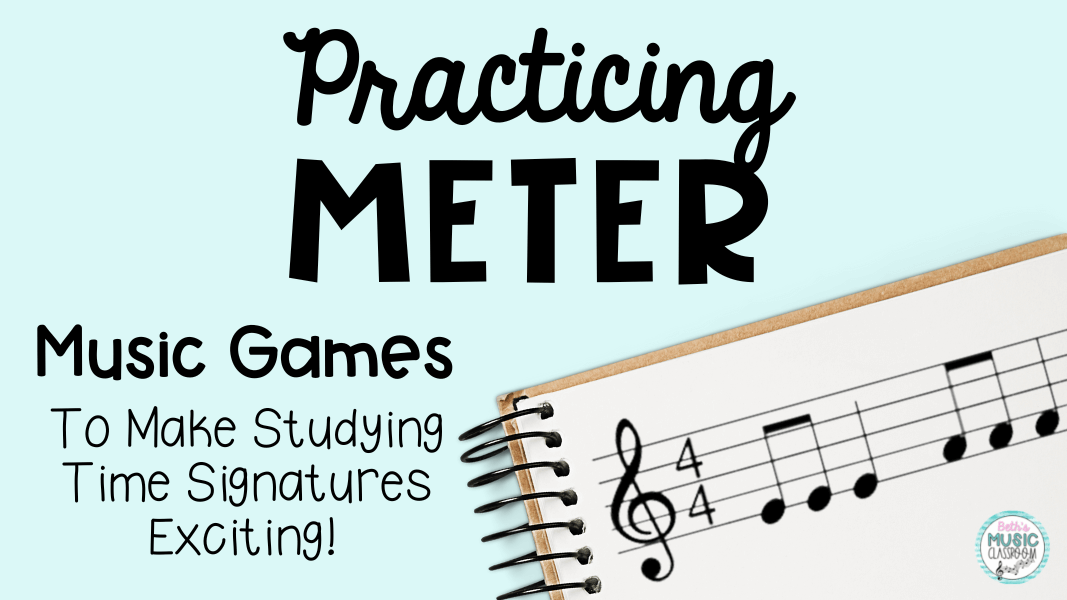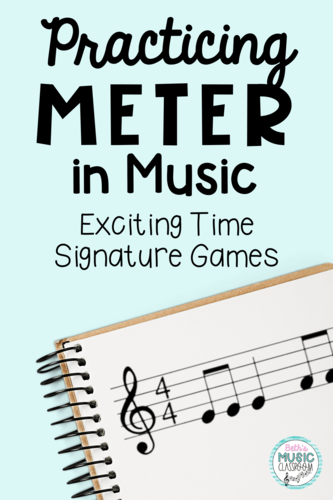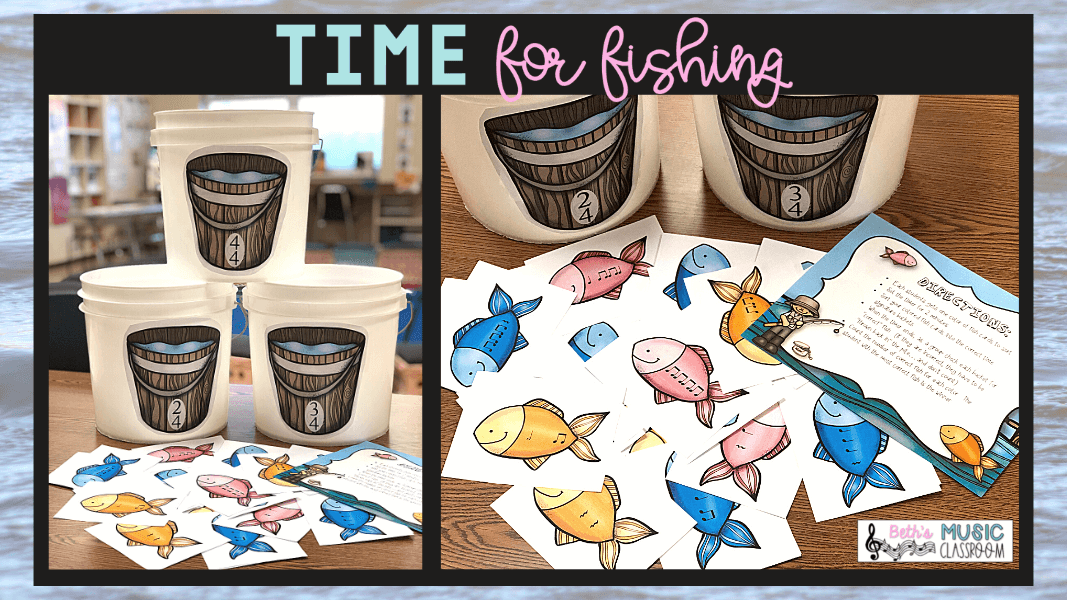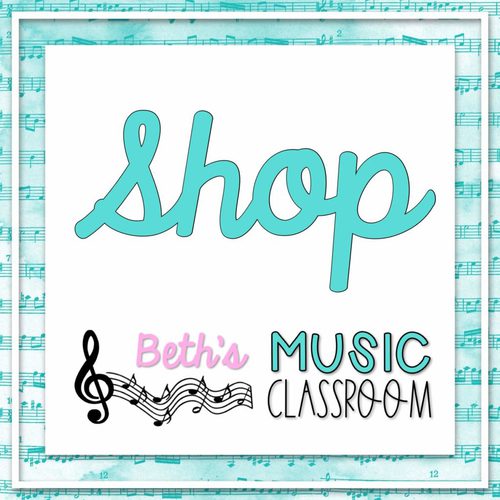Practicing Meter in Music: Exciting Time Signature Games

Practicing Meter – Time Signature Games Your Students will Love!
This post may contain affiliate links, where I may receive a small commission if you purchase something through following the link at no cost to you.
Welcome to part 2 in my series on teaching meter and time signatures to elementary music classes. If you haven’t read the part 1 yet, I suggest first reading it here: Teaching Meter in Music to Elementary Students – My Flight Plan for Teaching Meter. Then, you can come back here to read all about my review games and center ideas for practicing meter.
Meter and time signatures are definitely difficult concepts for students to grasp. It will be so important for them to recall as they enter older grades. Students need to fully grasp the concept.
As a child, I did not ever understand meter or time signatures. I learned it from hearing and memorizing, rather than it becoming real to me. So, that is my goal for my students each year. I want to make it understandable and real to them. I plan an extra day of games to solidify the concept of meter in music in their heads.
In this post, I want to share with you what my meter and time signature games look like and why it is so important to use games with your students.
Why Use Games?
First, let’s see why games are such an important part of elementary school and are present in each of my lessons. Kids love games – enough said. No, really though, they get excited when they hear “we’re playing a game today in music class.” So, they’re up for it, energetic, and excited to begin. Honestly, they could review or rethink the same material just sitting with a pencil doing worksheets, but for this abstract concept, I want them to live it – to experience it! Using time signature games will help students learn without even realizing it!
When I think of using games in my classroom, here are some of the benefits:
- A physical activity gets students up and moving (i.e. relay or race)
- A healthy competition to compete with their classmates
- A mental battle that they strive to put their whole mind and energy into
- An increased student participation and excitement to participate
- A drop in stress – as compared to test anxiety
Time Signature Games
Now, let the games begin! One of the beginning practice activities I use to teach meter is a simple rhythmic play along video. I love these because students can see the 2, 3, or 4 boxes layed out with the pointer highlighting the way. This helps students feel the strong beat on 1 and weak beats on the rest. Ready Go Music on YouTube does a wonderful job with their play along videos that are perfect for these beginning time signature activities. Here’s a few.
Secondly, here is another fun activity that I use to reinforce that strong and weak beats in students. This movement activity is a great brain break, and you can use it with body percussion or by bouncing a ball.
I have students listen to a piece of music and stomp on the strong beat. Then filling in the other beats in between with claps is easier. With the ball, have them try bouncing on beat 1 as the strong beat. After that, the rest of the beats are weak and will follow these motions depending on the meter: catch-raise-lower.
Also, you could add a student conductor activity – who uses a conductor baton or just their hands to show the strong beat down on 1, and so on. With this one, I printed up full-size direction pages, showing the proper way to conduct in 2, 3, and 4.
On the second day of teaching meter, I definitely like to include at least one meter identification game. This is a fun assessment that lets me see if my students can count and identify the time signature of a sample rhythmic selection. They read, clap, or speak a few measures, and then, using a time signature game like this one, they must determine if it is 2/4, 3/4, or 4/4 meter. I find that self-correcting games work so well when individual students or groups are working around the room or when I use centers. My students’ favorite game each year seems to be this one with a construction theme. They have a blast with it!
Next, my students absolutely love relay games for reviewing time signatures. These games are high energy, require fast moves and great matching skills. The object of the game is for each time to get all of their rhythm cards placed in the correct time signature container that is placed across the room. Each student takes a turn grabbing a card, running over, and determining where it should go.
My favorite has to be “Time for Fishing,” and each year my 3rd graders get totally hooked!
I also use this game in different themes or at different times of the year. Check them all out here in my Meter Bundle.
Here’s another time signature game, and this one requires no prep at all. Use this video for individual student or small group reinforcement, as a center, or as a closing activity. It counts down, gives multiple choice, and shows the correct answer, making it great for a substitute lesson.
Finally, I love making time signature review games into several exciting rounds of 4 corners – or in this case, I say 3 lanes for 2/4, 3/4, and 4/4 meter. I hang up 3 time signature signs to let students know where each one is. Now, with this one, I start off easy at first, clapping/playing one measure, and students must move to the time signature they hear. Then I gradually change to playing a song or piece of music with a clear meter of 2, 3, or 4.
Since students had already practiced this earlier in this meter unit (stomping on the strong beat and clapping on all of the weak beats), I often notice that they will try that out with this musical meter game. It helps them figure it out – especially the kinesthetic learners in your classroom.
You can play this game a few different ways. You may choose to eliminate those who answered wrong. Or you could instead have students choose a lane first, then play the music, and anyone in the correct lane is out.
Time Signature Centers
In each of my meter lessons, I spend some time playing at least one of these games (for the reasons listed above). I want my students to have fun learning musical meter and look forward to class each week.
Some years, depending on available time, I add a meter centers day to the end of this unit. I choose 5-8 time signature games and set them up around the room. I use full-size posters with center #s to avoid confusion. For 4-6 minutes, a small group of no more than 4 students work together at each of the centers. Then I play a rhythm on the cowbell, signifying it’s time to “reset the station.” The second time I play the cowbell, each group advances to the next station.
If you’re interested in trying out some time signature centers, here’s a few tips:
- It’s okay if every student doesn’t make it to every station. As long as they make it to every type of meter game. I have 2 similar games set up at #1 and 5, just in case one class doesn’t get as far.
- Organize station manipulatives so that they are easy to access and put away (i.e. dice, game pieces, spinners, clothespins, sand timers, etc.).
- Use large center # posters, displayed clockwise or counter-clockwise around your space.
- Establish a clear sound or system for cleaning up/resetting and rotating stations.
I hope that you are able to take away some ideas and activities from this list of exciting time signature games. If so, I’d love to hear how they go in your classroom! Or if you have any questions or meter game suggestions, leave a comment below. You can also find me on Instagram (@bethsmusicclassroom) or email me at beth@bethsmusicclassroom.com.
If you’re looking for some more elementary music ideas, check out this post on how to organize your composer of the month materials.

Exciting Time Signature Games for Practicing Meter



